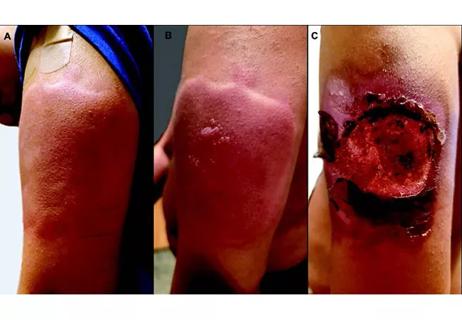When the pandemic hit, the institute was able to stay agile and adapt, thanks to existing infrastructure

During the early days of the COVID-19 pandemic, the Head and Neck Institute suddenly and successfully used telemedicine to care for patients. Prior to the pandemic, just 0.3% of all visits to the Head & Neck Institute at Cleveland Clinic were virtual, and were additionally scattered among a small number of providers. However, virtual visits skyrocketed to 70% of all visits when the pandemic hit, with all providers suddenly providing care to patients remotely.
Advertisement
Cleveland Clinic is a non-profit academic medical center. Advertising on our site helps support our mission. We do not endorse non-Cleveland Clinic products or services. Policy
“Before COVID-19, I would have about eight slots a month, and I was our highest-volume virtual visit provider,” says Erika Woodson, MD, the Section Head of Neurotology/Otology/Lateral Skullbase Surgery and the Telehealth Advocate for the Head and Neck Institute. “Virtual visits were used on an as-needed basis, rather than as the modus operandi. But when COVID-19 lockdowns happened, suddenly everyone had to transition.”
Before COVID-19, Cleveland Clinic had already set an institutional goal to grow telemedicine. This meant there was infrastructure already in place to help the organization pivot once lockdowns occurred. Meetings occurred almost daily, and emails were sent out almost continuously, to train and prepare the clinicians for this new reality. “It was a massive effort”, said Dr. Woodson, acknowledging the determination everyone brought to the cause. “We thought we had five years to work towards our goals. Instead, we had five days!”
Several factors contributed to the limited growth of telemedicine across the US, but government action prompted by the pandemic removed some of the most obtrusive barriers. The emergency declarations paved the way for parity in insurance coverage for virtual and in-person visits for patients with Medicare, Medicaid and commercial payers. Additionally, HIPAA restrictions on virtual platforms were suspended, allowing providers to counsel patients through Facebook, Google Duo, Zoom or other programs the patients could manage. This gave the team the flexibility to support the increased number of visits and eliminated the need to train physicians who were unfamiliar with Cleveland Clinic’s preexisting telemedicine platform.
Advertisement
Cleveland Clinic addressed another major barrier by removing copays for all telemedicine visits in the early days of the COVID-19 outbreak. Prior to the pandemic, virtual visits operated under a fee-for-service model, because insurers would not routinely offer payment for these services, Dr. Woodson explained. “This change allowed the department to reach patients who we weren’t reaching before—patients who weren’t able to afford, or didn’t see the value of telemedicine with our pre-existing fee-for-service model.” With no co-pay, and hesitation to come into the office during the lockdown, patients were much more open to trying telemedicine.
Although the removal of these barriers improved access to telemedicine, there are still numerous technologic limitations for the problems that the Head and Neck Institute can treat virtually. “The general nature of otolaryngology is that there’s not a lot that you can examine through a screen,” says Dr. Woodson. “You can’t look in a nose, you can’t look in an ear and you can’t look deep into the throat. That’s everything we do. For us, the emphasis with virtual visits turns into a lot more history-taking and data review such as imaging, more so than the physical exam.”
Cleveland Clinic decided to resume elective surgeries and outpatient clinics in May 2020, and the Head & Neck Institute moved quickly back to an in-person model of care. Because of the aforementioned technology limits, many patients were triaged, knowing that they would need in-person care when it was safe to do so. To accommodate the pent-up demand for in-person care, virtual visits dramatically decreased when clinics reopened. Virtual visits represent approximately 5% of outpatient visits at the time the article was written.
Advertisement
Dr. Woodson says, “One of the things that everybody’s worried about with the shutdown is the consequences of delayed care—people who didn’t receive the preventive care or procedures they needed. We are going to see patients come in with more advanced disease because of that delay in seeking care.”
While telemedicine limitations exist, Dr. Woodson notes there are certain benefits to providing care virtually. Some may argue that virtual visits seem more impersonal because the patient and caregiver are not in the same room, but she believes this might not necessarily be true. “When I’m in the patient’s room, I have a mask on and a face shield, and so do they,” says Dr. Woodson. “To me, that feels a lot less personal than a virtual conversation where I can see a patient’s face and their expressions, and they can see mine.”
Another point she brings up is the restrictions on visitors for in-person visits due to COVID-19. While Cleveland Clinic currently limits in-person visits to just the patient and their physician, virtual visits do not have the same restrictions. Having a family member at the appointment can help ensure the patient is understanding everything, which increases compliance and patient satisfaction. For complex care and decision-making, a virtual appointment may be the best option.
While there are obvious limitations to telemedicine for head and neck physicians, Dr. Woodson says the department still has plans to expand its use. One area that she would like to see telemedicine used is improving care to rural patients, the elderly and the socioeconomically disadvantaged—all populations with different technology gaps that limit their access to these services.
Advertisement
Dr. Woodson explains, “I’ve challenged each of our subspecialty sections to determine what patient population we can treat virtually, or at least provide second opinions virtually. Telemedicine can allow patients to receive care from Cleveland Clinic physicians, even if they are far away. If we don’t have the ability to see them physically in person, there’s still a lot we can do to advise them or advise their local provider about taking care of their problem. The demand for virtual care is not going to go away, and I’m excited to see how our use of it matures.”
Advertisement
Advertisement

Patients report improved sense of smell and taste

Clinicians who are accustomed to uncertainty can do well by patients

Unique skin changes can occur after infection or vaccine

Cleveland Clinic analysis suggests that obtaining care for the virus might reveal a previously undiagnosed condition

As the pandemic evolves, rheumatologists must continue to be mindful of most vulnerable patients

Early results suggest positive outcomes from COVID-19 PrEP treatment

Could the virus have caused the condition or triggered previously undiagnosed disease?

Five categories of cutaneous abnormalities are associated with COVID-19